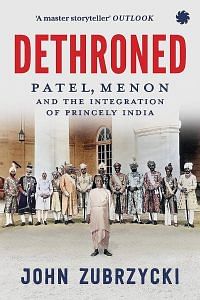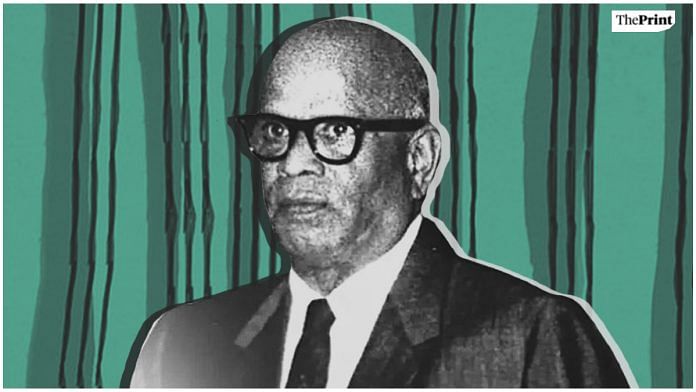A fortnight before the transfer of power, twenty-six rulers in Orissa and fifteen in Chhattisgarh had formed the Eastern States Union, in the belief that united they stood a better chance of defending themselves against the Congress juggernaut. They were wrong. The union proved to be unviable. The states were scattered over a large area with no linguistic or ethnic bonds holding them together. By the beginning of 1948, barely a handful had allowed partial responsible government, setting the stage for ugly confrontations between the rulers and the local Praja Mandals. At Dhenkanal, only the presence of a tame leopard in the zenana prevented the takeover of the ruler’s palace.
The trigger for the states ministry to act came when the establishment of an ‘Azad Nilgiri Government’ by the Praja Mandal in Nilgiri state, one of the members of the union, sparked a pro-raja uprising in November 1947 by adivasis armed with bows and arrows. When the state’s ruler ordered armed tribals to attack Praja Mandal supporters and property, units of the Orissa Military Police Force took over the administration. Another concern for the states ministry was that Hyderabad might carve out a slice of the mineral-rich state of Bastar in Chhattisgarh for itself. Patel would later cite attempts by the nizam’s agents to entrap its young ruler and convince him to merge with Hyderabad as shaping his views on partition. The prince’s vulnerability to the machinations of the Political Department (which supported such a merger) led him to conclude ‘that the best course was to drive out the foreigners even at the cost of the partition of the country. It was also then that I felt that there was only one way to make the country safe and strong and that was the unification of the rest of India.’
As the situation in the Eastern States Union continued to deteriorate, Patel proposed that the states cede some of their powers to the neighbouring provincial governments of Orissa and Bihar. Aware of the potential backlash from the larger states in the union, he and Menon decided to target the smaller so-called B and C states first. Menon in particular knew that getting a deal would need a great deal of sweetening. ‘Since they were surrendering their States for all time, it was but elementary justice that some form of quid pro quo should be conceded to them,’ Menon later wrote.
The draft merger agreement Patel and he carried to them would become a template for all future mergers over the next eighteen months. Under the agreement, the rulers would surrender all their governing powers in return for a guaranteed privy purse, amounting to approximately 10 per cent of the revenues of their states as they stood in 1947, subject to a maximum of Rs 10 lakh (this figure was sometimes exceeded). The privy purse would be tax-free, an important concession, given the high levels of taxation in India at the time. All rulers were allowed to retain their palaces and certain other property, their personal privileges and those of their immediate family and, most importantly, their titles. The agreement also provided that the rulers’ authority, jurisdiction and power would be ceded in favour of the central and not provincial governments.12According to H.V. Hodson, Patel won approval for the policy at a cabinet meeting ‘after one minute’s explanation and no comment’. The issue of privy purses and privileges would be a subject of controversy for decades to come.
On 13 December 1947, Menon and Patel travelled to Cuttack and invited the rulers of the Orissa states to a meeting. Though they sat on potentially rich deposits of minerals and coal, the states were mostly poor with incomes often too meagre to meet the requirements of administration. A 1939 enquiry had found that some of the more autocratic rulers were demanding that tenant farms pay around a quarter of their annual land rent just to meet the cost of royal marriages and religious ceremonies. In the case of Dhenkanal, the tenants were forced to hand over part of their income to fund a trip to Europe by the ruler’s brother. ‘This extra taxation prevails in almost all the Orissa States and it has been a source of considerable hardship to the people called upon to bear the heavy burden,’ the enquiry report stated. ‘No fundamental rights of citizenship are recognised. Civil liberty is crushed, and the people are daily oppressed with a feeling of potential danger to the security of life and property.’14 Commenting on the negotiations in Cuttack, Menon wrote:
They [the rulers] realised that their continued existence depended on the goodwill of their people and the support of the Government of India, both of which they lacked and that if, owing to agitation, the administration of their States were ultimately taken over by the Government of India, they might not even get the privy purses which were being guaranteed to them.
By evening all the small states had agreed to a merger.
Convincing the larger states in the Eastern States Union proved more difficult. Pratap Singh Deo, the raja of Patna, wanted time to consider the offer. Patel was due to travel to Nagpur the following day and wanted the agreement before he departed. As Menon revealed to Hodson years later, he persuaded the Raja of Dhenkanal to tell Patna’s ruler that if he and the others refused to sign ‘he [Menon] was going to issue orders there and then that they must remain in Cuttack and that as soon as sufficient numbers of reserve police could be assembled, the States Ministry was going to occupy the states’. When Singh Deo checked with Menon if there was any truth to the threat, he not only confirmed there was but also agreed to put in writing that if the ruler did not sign the agreement, ‘the Government of India would be compelled to take over [his] administration’. C.C. Desai, Menon’s assistant, was even less tactful. When the prince of a small central Indian state pleaded for time to consider what he should do, Desai told him: ‘Either you sign what we have got now or you do not sign at all, and you take the consequences of your action. Our Crown Reserve Police [sic] would walk into the State and you are free to take such steps as may be open to you.’
The success of Menon’s arm-twisting could be measured in the rapid-fire headlines it generated. ‘Mr V.P. Menon visits state of Chhota Hazri’, would be followed a day later by a brief note that ‘HH the Maharajah of Chhota Hazri has arrived’, culminating in the banner headline, ‘CHHOTA HAZRI MERGED!’ The scoresheet at the end of the process was twenty states merging with Orissa, fifteen with the Central Provinces and two with Bihar.
 This excerpt from ‘Dethroned’ by John Zubrzycki has been published with permission from Juggernaut.
This excerpt from ‘Dethroned’ by John Zubrzycki has been published with permission from Juggernaut.



